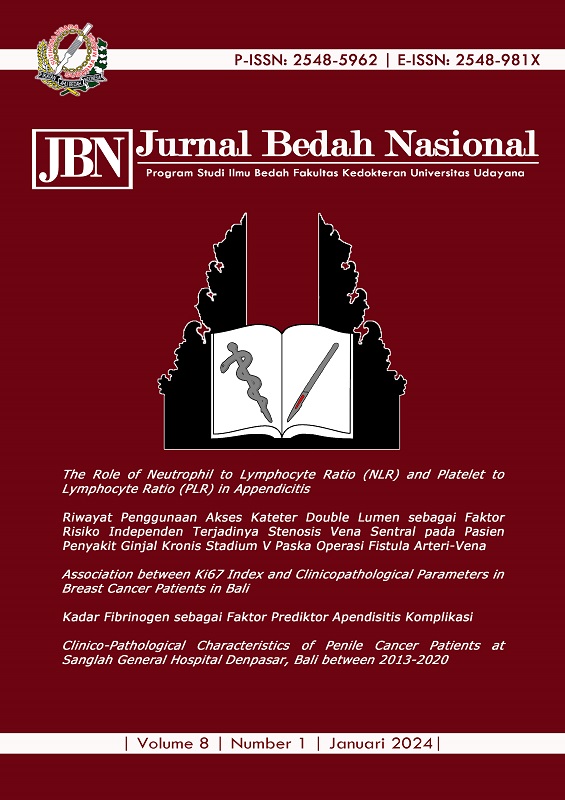Association between Ki67 Index and Clinicopathological Parameters in Breast Cancer Patients in Bali
Abstract
Aim: To assess the association between Ki67 index and various clinicopathological parameters of breast cancer patients in Bali. Methods: This was a cross-sectional study of breast cancer patients at Prof. Dr. I. G. N. G Ngoerah Hospital, a referral hospital in Bali, from 1 January 2021 to 31 December 2021. Clinicopathology data was taken from SIMARS and archives in the Anatomical Pathology Laboratory. Ki67 index was assessed by immunohistochemical examination, categorized into low (Ki67 index <20%) and high (Ki67 index?20%). Association between Ki67 index with clinicopathological parameters was analysis with X2 test with significance level determined at ?=0.05. Results: There were 75 cases of breast cancer patients with a mean age was 50.74 ± 10.05 years old. Low Ki67 index was found in 9 (12%) cases, while high Ki67 index in 66 (88%) cases. There was a significant association between Ki67 index and histological grade of the tumor (p=0.007), nodal status (p=0.014), and molecular subtype of tumor (p=0.007). There was no significant association between Ki67 index and the patient's age (p=0.268), histological subtype (p=0.086), and T stage (p=0.511). Conclusion: Ki67 index has significant association with histological grade of the tumor, nodal status, and the molecular type of the tumor in breast carcinoma patients in Bali.
Downloads
References
2. Davey MG, Hynes SO, Kerin MJ, et al. Ki-67 as a prognostic biomarker in invasive breast cancer. Cancers (Basel). 2021;13(17):4455.
3. Nguyen D, Yu J, Reinhold WC, et al. Association of Independent Prognostic Factors and Treatment Modality with Survival and Recurrence Outcomes in Breast Cancer. JAMA Netw Open. 2020;3(7): e207213.
4. Fasching PA, Heusinger K, Haeberle L, et al. Ki67, chemotherapy response, and prognosis in breast cancer patients receiving neoadjuvant treatment. BMC Cancer. 2011;11:486.
5. Dowsett M, Nielsen TO, A’Hern R, et al. Assessment of Ki67 in Breast Cancer: Recommendations from the international Ki67 in breast cancer working Group. J Natl Cancer Inst. 2011;103(22):1656-1664.
6. Nielsen TO, Leung SCY, Rimm DL, et al. Assessment of Ki67 in Breast Cancer: Updated Recommendations From the International Ki67 in Breast Cancer Working Group. J Natl Cancer Inst. 2021;113(7):808-819.
7. Lombardi A, Lazzeroni R, Bersigotti L, et al. The proper Ki-67 cut-off in hormone responsive breast cancer: A monoinstitutional analysis with long-term follow-up. Breast Cancer Targets Ther. 2021;13:213-217.
8. Hashmi AA, Hashmi KA, Irfan M, et al. Ki67 index in intrinsic breast cancer subtypes and its association with prognostic parameters. BMC Res Notes. 2019;12:605.
9. Ragab HM, Samy N, Afify M, at al. Assessment of Ki-67 as a potential biomarker in patients with breast cancer. J Genet Eng Biotechnol. 2018;16(2):479-484.
10. Rakha EA, El-Sayed ME, Lee AHS, et al. Prognostic significance of nottingham histologic grade in invasive breast carcinoma. J Clin Oncol. 2008;26(19):3153-3158.
11. Yin Y, Zeng K, Wu M, et al. The levels of Ki-67 positive are positively associated with lymph node metastasis in invasive ductal breast cancer. Cell Biochem Biophys. 2014;70(2):1145-1151.
12. Putra AS, Supadmanaba IGP, Adiputra PAT. Descriptive analysis of clinicopathological characteristics of breast cancer in Sanglah General Hospital, Bali. Annals of Oncology. 2017; 28(Suppl 10):x176.
13. Chang JM, Leung JWT, Moy L, et al. Axillary nodal evaluation in breast cancer: State of the art. Radiology. 2020;295(3):500-515.
14. Li FY, Wu SG, Zhou J, et al. Prognostic value of Ki-67 in breast cancer patients with positive axillary lymph nodes: A retrospective cohort study. PLoS One. 2014;9(2):e87264.
15. Soliman NA, Yussif SM. Ki-67 as a prognostic marker according to breast cancer molecular subtype. Cancer Biol Med. 2016;13(4):496-504.
16. Al-Zawi ASA, Elamass M, Kapturek A, et al. Ki-67 proliferative index correlation to the immunohistochemistry profile in early female breast cancer: a review of 515 cases. Med Res J. 2021;6(2):108-113.
17. Nikolov S, Enchev E, Minkov G, et al. The role of the molecular subtypes in the prognosis of cancer patients. Open Access Maced J Med Sci. 2020;8(B):133-138.

This work is licensed under a Creative Commons Attribution 4.0 International License.
Program Studi Ilmu Bedah Fakultas Kedokteran Universitas Udayana. 
This work is licensed under a Creative Commons Attribution 4.0 International License.






